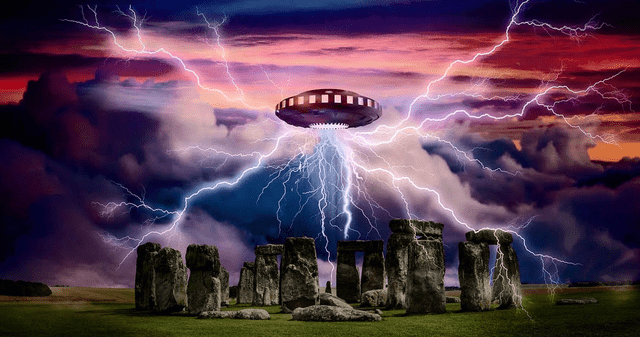
Ancient Alien Theory
April 11, 2024
The Ancient Alien Theory, also known as the Ancient Astronaut Theory, posits that extraterrestrial beings visited Earth in ancient times and interacted with early human civilizations. This theory suggests that these advanced beings may have influenced or even been responsible for various technological advancements, cultural developments, and historical events documented in ancient texts and archaeological findings.
One of the earliest mentions of the Ancient Alien Theory can be traced back to the writings of Swiss author Erich von Däniken. In his 1968 book “Chariots of the Gods?”, von Däniken proposed that many ancient structures, artifacts, and myths around the world could be interpreted as evidence of contact with extraterrestrial beings. He suggested that ancient peoples may have mistaken these visitors for gods and incorporated their encounters into their religious beliefs and cultural practices.
There is a great amount of evidence supporting the Ancient Alien Theory. Some proponents of the theory argue that the construction of megalithic structures such as the Pyramids of Giza, Stonehenge, and Tiwanaku could not have been achieved by ancient civilizations alone and must have involved advanced alien technology.
Certain ancient artifacts, such as the crystal skulls and the Antikythera Mechanism, have been cited as potential examples of advanced technology that may have been influenced by extraterrestrial beings. Supporters of the theory often point to ancient texts like the Indian Vedas, Sumerian tablets, and Mayan codices, which contain descriptions of flying objects, technologically advanced beings, and interactions with otherworldly entities.
While considered pseudo science there are notable scientists who have expressed an interest in or support for the Ancient Alien Theory. While not a proponent of the theory, Carl Sagan, a renowned astronomer and astrophysicist, acknowledged the possibility of extraterrestrial life and the need for scientific investigation into claims of ancient astronaut visitations. An astronomer and co-founder of the SETI Institute, Jill Tarter has conducted research into the search for extraterrestrial intelligence and remains open to the idea of contact with advanced alien civilizations in the past. Though primarily known for his work in ufology and investigating UFO sightings, nuclear physicist Stanton Friedman has also touched on the Ancient Alien Theory in his research and public engagements.
There are ongoing archaeological expeditions and research projects that explore the possibility of ancient astronaut visitations on Earth. While mainstream archaeology tends to focus on conventional explanations for ancient civilizations and their achievements, there are researchers and organizations dedicated to investigating the Ancient Alien Theory and its implications. The Nazca Lines in Peru have long been associated with the Ancient Alien Theory due to their massive scale and intricate designs that are best appreciated from the air. Some researchers believe that these geoglyphs may have had an extraterrestrial connection. Ongoing research seeks to understand the purpose and creation methods of the Nazca Lines.
Gobekli Tepe in Turkey is one of the most significant archaeological sites in the world, dating back over 11,000 years. Some proponents of the Ancient Alien Theory suggest that the construction of Gobekli Tepe’s massive stone pillars with intricate carvings may have been influenced by advanced beings. Ongoing excavations and research at Gobekli Tepe aim to uncover more about its origins and purpose.
Puma Punku in Bolivia is part of the larger Tiwanaku archaeological site and features complex stone structures with precise cuts and alignments. Some researchers speculate that the construction techniques used at Puma Punku could be beyond the capabilities of ancient civilizations and might indicate extraterrestrial involvement. The Ancient Astronaut Society is an organization dedicated to researching and promoting the Ancient Alien Theory. They support various research projects, conferences, and publications that explore the potential connections between ancient civilizations and extraterrestrial visitations.While these projects are not universally accepted within the archaeological community, they contribute to the ongoing discussion about the influence of possible ancient astronauts on Earth’s history and the development of human civilizations.
Naturally there are criticisms and counterarguments raised against the Ancient Alien Theory in relation to the Nazca Lines, Gobekli Tepe, and Puma Punku. Critics argue that ancient civilizations had the capability to create the Nazca Lines using simple tools and techniques. They highlight examples of large-scale ancient earthworks created by human societies around the world.
Some researchers suggest that the Nazca Lines were created for religious or ceremonial purposes rather than as messages or markers for extraterrestrial beings. The cultural context and practices of the Nazca people are often emphasized in these arguments. Skeptics of the Ancient Alien Theory point out that there is no concrete physical evidence linking the Nazca Lines to extraterrestrial beings. Without tangible proof, they argue that attributing the lines to alien influence is speculative.
Opponents of the Ancient Alien Theory suggest that human knowledge and capabilities evolved over time, allowing ancient societies to develop sophisticated structures like Gobekli Tepe without extraterrestrial assistance. Critics argue that the construction of Gobekli Tepe could be explained by the use of local resources, skilled labor, and communal effort. They point to evidence of gradual societal advancement and architectural development in the region. Some scholars emphasize the importance of understanding the cultural and symbolic significance of Gobekli Tepe within the context of ancient societies rather than projecting modern interpretations or extraterrestrial narratives onto the site.
There is the lack of direct evidence linking Puma Punku’s construction to extraterrestrial beings. They highlight the absence of specific artifacts or inscriptions that clearly indicate alien involvement.
Critics propose alternative explanations for the advanced stonework seen at Puma Punku, such as the use of lost or unknown construction techniques by ancient Andean civilizations. They suggest that the precision and complexity of the site can be attributed to human ingenuity and skill.
Those against the Ancient Alien Theory stress the importance of considering the historical and cultural context of Puma Punku within the broader narrative of ancient Andean civilizations. They argue that attributing the site to extraterrestrial influence overlooks the achievements and capabilities of past human societies.
The ancient aliens theory presents a fascinating perspective on the mysteries of ancient civilizations and their remarkable constructions. By considering the possibility of extraterrestrial influence or intervention, we open our minds to alternative explanations for enigmatic sites like the Nazca Lines, Gobekli Tepe, and Puma Punku. The theory offers a compelling framework to interpret complex structures, advanced technological feats, and cultural anomalies that defy understanding.
While skepticism and debate continue to surround the ancient aliens hypothesis, it serves as a thought-provoking lens through which we can explore the depths of human history and the potential connections with beings beyond our world. Embracing the ancient aliens theory encourages us to contemplate the vastness of the universe and the countless possibilities that may have shaped our past, inviting us to ponder the incredible richness of our planet’s ancient heritage.















